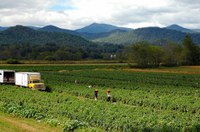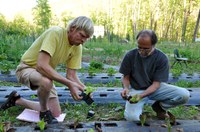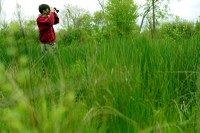Demographics and Social Values
How resources are used depends on who is using them
The ways in which people obtain benefits from the landscapes around them can depend on culture, age, and many other social factors. For example, the land use preferences and opportunities of people living in rural areas can be very different from those of people in cities. Even within a single Appalachian community, the ecological benefits that different people choose to utilize vary (e.g., hunting versus bird watching). These differences can be associated with income, age, and other demographic factors.
Demographic patterns across landscapes may relate in unexpected ways to natural resource use and to the consequences of environmental change. Factors at work in Appalachia include race, income, culture, and religious beliefs. Communities in poverty may lack the means to adapt to extreme weather events such as droughts and flooding, and they can therefore be more vulnerable than others to climate change. Poverty can also restrict basic access to many ecosystem services, such as recreational uses and even clean water. Rural Appalachian communities can be cultural repositories of traditional ecological knowledge that drive activities such as harvesting nontimber forest products (e.g., ginseng).
Societal needs and ethics inform choices about resource use
Social values strongly shape how people interact with landscapes, because these values define what kinds of ecosystem services people are interested in. Where different people hold different values, conflicts over ecosystem services can and do arise, underscoring the importance of including these considerations in land management strategies. However, finding ways to integrate social values into inclusive decision-making processes can be challenging. Demographic factors have been used as proxies for social values with some success. Another strategy is to estimate monetary values for ecosystem services, for example by evaluating people’s “willingness to pay” for a particular service—this translates social values into perhaps more tangible economic terms.
These efforts can be complex because demographic and economic realities interact with social values, or preferences, in ways that are different from one community to the next. For land managers, this makes it important to consider different landscapes in terms of their unique social—as well as ecological—contexts. The complexity of conservation in Appalachia arises not only from the diversity of ecosystems in the region, but also from its varied demographics.
Demographic data can help to reveal geographic patterns in ecological benefits and risks, and how these change over time with societal shifts. Rural communities, for example, may be displaced as regions urbanize, land values rise, dominant social values shift, and land uses change. Social and ecological change are thus intertwined, and addressing the concerns of everyone involved can improve outcomes for Appalachian communities and landscapes.
In summary, understanding how and why people make the decisions they do about land and natural resources is important for understanding ecosystem service use. Incorporating these realities into resource management decision-making can be an opportunity for building community consensus and improving sustainability.
 Demographics and
|
 Economics and Business
|
|
References
Bowker, J. M., and A. Askew. 2013. Outlook for outdoor recreation in the northern United States. A technical document supporting the Northern Forest Futures Project with projections through 2060. Gen. Tech. Rep. NRS-120. USDA Forest Service, Northern Research Station: 62 pp.
Bowker, J. M., A. Askew, H. K. Cordell, and J. C. Bergstrom. 2013. Outdoor recreation, Chapter 8, 161–182. In D. N. Wear and J. G. Greis, editors, The Southern Forest Futures Project: Technical Report. Gen. Tech. Rep. SRS-178, USDA Forest Service, Southern Research Station: 542 pp.
Brandt, L., H. He, L. Iverson, F. R. Thompson, III, P. Butler, S. Handler, M. Janowiak, P. D. Shannon, C. Swanston, M. Albrecht, R. Blume-Weaver, P. Deizman, J. DePuy, W. D. Dijak, G. Dinkel, S. Fei, D. T. Jones-Farrand, M. Leahy, S. Matthews, P. Nelson, B. Oberle, J. Perez, M. Peters, A. Prasad, J. E. Schneiderman, J. Shuey, A. B. Smith, C. Studyvin, J. M. Tirpak, J. W. Walk, W. J. Wang, L. Watts, D. Weigel, and S. Westin. 2014. Central Hardwoods ecosystem vulnerability assessment and synthesis: a report from the Central Hardwoods Climate Change Response Framework project. Gen. Tech. Rep. NRS-124, USDA Forest Service, Northern Research Station: 254 pp.
Butler, P., L. Iverson, F. R. Thompson, III, L. Brandt, S. Handler, M. Janowiak, P. D. Shannon, C. Swanston, K. Karriker, J. Bartig, S. Connolly, W. D. Dijak, S. Bearer, S. Blatt, A. Brandon, E. Byers, C. Coon, T. Culbreth, J. Daly, W. Dorsey, D. Ede, C. Euler, N. Gillies, D. M. Hix, C. Johnson, L. Lyte, S. Matthews, D. McCarthy, D. Minney, D. Murphy, C. O'Dea, R. Orwan, M. Peters, A. Prasad, C. Randall, J. Reed, C. Sandeno, T. Schuler, L. Sneddon, B. Stanley, A. Steele, S. Stout, R. Swaty, J. Teets, T. Tomon, J. Vanderhorst, J. Whatley, and N. Zegre. 2014. Central Appalachians ecosystem vulnerability assessment and synthesis: a report from the Central Appalachians Climate Change Response Framework. Gen. Tech. Rep. NRS-124, USDA Forest Service, Northern Research Station: 310 pp.
Chamberlain, J. L. 2006. Conserving the Appalachian medicinal plant industry, 5–16. In Proceedings, Fourth Annual Symposium on Appalachian Opportunities - Medicinal and Aromatic Plants, Beckley, WV, 16–17 September 2005.
Cho, S.-H., N. C. Poudyal, and R. K. Roberts. 2008. Spatial analysis of the amenity value of green open space. Ecological Economics66(2–3): 403–416.
Duncan, C. M., and N. Lamborghini. 1994. Poverty and social context in remote rural communities. Rural Sociology 59(3): 437–461.
Cooper, C., L. Larson, A. Dayer, R. Stedman, and D. Decker. 2015. Are wildlife recreationists conservationists? Linking hunting, birdwatching, and pro‐environmental behavior. The Journal of Wildlife Management 79(3): 446–457.
Cordell, H. K., C. J. Betz, and S. H. Mou. 2013. Outdoor recreation in a shifting societal landscape, Chapter 7, 123–160. In D. N. Wear and J. G. Greis, editors, The Southern Forest Futures Project: Technical Report. Gen. Tech. Rep. SRS-178, USDA Forest Service, Southern Research Station: 542 pp.
Cordell, H. K., C. J. Betz, S. H. Mou, and D. D. Gormanson. 2012. Outdoor recreation in the Northern United States. Gen. Tech. Rep. NRS-100. USDA Forest Service, Northern Research Station: 74 pp.
Cordell, H. K., V. Heboyan, F. Santos, and J. C. Bergstrom. 2011. Natural amenities and rural population migration: a technical document supporting the Forest Service 2010 RPA Assessment. Gen. Tech. Rep. SRS-146. USDA Forest Service, Southern Research Station: 23 pp.
Keyser, T., J. Malone, C. Cotton, and J. Lewis. 2014. Outlook for Appalachian-Cumberland forests: a subregional report from the Southern Forest Futures Project. General Technical Report SRS-GTR-188. USDA Forest Service, Southern Research Station: 83 pp.
Lal, P., J. R. R. Alavalapati, and E. Mercer. 2011. Socio-economic impacts of climate change on rural United States. Mitigation and Adaptation Strategies for Global Change 16(7): 819–844.
Law, J., and K. McSweeney. 2013. Looking under the canopy: Rural smallholders and forest recovery in Appalachian Ohio. Geoforum 44: 182–192.
Morzillo, A. T., C. R. Colocousis, D. K. Munroe, K. P. Bell, S. Martinuzzi, D. B. Van Berkel, M. J. Lechowicz, B. Rayfield, and B. McGill. 2015. “Communities in the middle”: Interactions between drivers of change and place-based characteristics in rural forest-based communities. Journal of Rural Studies 42: 79–90.
Nesbitt, J. T., and D. Weiner. 2001. Conflicting environmental imaginaries and the politics of nature in Central Appalachia. Geoforum 32(3): 333–349.
Southern Appalachian Man and the Biosphere (SAMAB). 1996. The Southern Appalachian Assessment: Social, Cultural, and Economic Technical Report. Report 4 of 5, USDA Forest Service, Southern Region: 228 pp.
Tarrant, M. A., and H. K. Cordell. 1999. Environmental justice and the spatial distribution of outdoor recreation sites: An application of geographic information systems. Journal of Leisure Research 31(1): 18–34.
Tarrant, M. A., and R. B. Hull. 2004. Forest values and attitudes in the South: Past and future research, 231–239. In H. M. Rauscher and K. Johnsen, editors, Southern Forest Science: Past, Present, and Future. Gen. Tech. Rep. SRS-75, USDA Forest Service, Southern Research Station: 394 pp.
U.S. Department of Agriculture Forest Service. 2012. Future of America's Forests and Rangelands: Forest Service 2010 Resources Planning Act Assessment. Gen. Tech. Rep. WO-87. USDA Forest Service: 198 pp.
Wear, D. N., R. Huggett, R. Li, B. Perryman, and S. Liu. 2013. Forecasts of forest conditions in regions of the United States under future scenarios: a technical document supporting the Forest Service 2012 RPA Assessment. Gen. Tech. Rep. SRS-GTR-170. USDA Forest Service, Southern Research Station: 101 pp.
Wickham, J., P. B. Wood, M. C. Nicholson, W. Jenkins, D. Druckenbrod, G. W. Suter, M. P. Strager, C. Mazzarella, W. Galloway, and J. Amos. 2013. The overlooked terrestrial impacts of mountaintop mining. BioScience 63(5): 335–348.


























